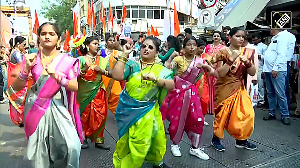Why is the Congress so aggressive in its defence of P Chidambaram?
Simple, Chidambaram is the last seawall preventing the tsunami of the 2G scam from inundating the prime minister.
Let me put forward an assertion at this point: Dr Subramanian Swamy is probably Dr Manmohan Singh's best friend in politics today. This may sound weird given the persistence with which Dr Swamy has pursued the 2G case for several years. But consider this, up until a short time ago even members of the Opposition conceded in private that the poor prime minister was untainted; today Dr Swamy is the only major political figure outside the Congress who might say so.
Why is that?
The 2G scam has been called 'India's Watergate', and this reminds me of an episode from the tumultuous years that drove an American president out of the White House. Confronted by a thicket of crimes and cover-ups, Senator Howard Baker cut through the tangle with a single question: 'What did the President know, and when did he know it?'
The question is famous; what is less well-remembered is that Senator Baker was, like the then president, a Republican. It was an implicit recognition that the Republican Party had recognised that Richard Nixon was becoming a liability.
We do not know if any Congressman would question Dr Manmohan Singh, but Howard Baker's question still resonates. What did the prime minister know, and when did he know it?
Drawing up a timeline we find that the story begins in 2003. It was in that year that the Atal Bihari Vajpayee ministry decided that spectrum pricing should be decided by a group of ministers. The National Democratic Alliance called a general election six months before one was due, and it was then replaced by a UPA ministry under Dr Manmohan Singh. The policy, however, was not changed, and in 2006 a group of ministers under Pranab Mukherjee (then external affairs minister) was to discuss the issue.
The then communications minister, Dayanidhi Maran, protested furiously. On February 1, 2006, he met Dr Manmohan Singh to insist that the issue of pricing should not be placed before the group of ministers.
On February 28, Dayanidhi Maran -- amid all the bustle of Budget Day -- wrote to the prime minister reminding him of his assurance that 'the terms of reference of the GoM would be drawn up exactly the way we wanted, which was to focus only on the issue of vacation of spectrum'. The letter included precise details of the terms of reference for the group of ministers.
From Jawaharlal Nehru to Atal Bihari Vajpayee, has any prime minister received so insolent a letter from one of his colleagues? Dayanidhi Maran was virtually dictating to Dr Manmohan Singh.
The terms of reference were diluted under the DMK minister's pressure, removing pricing from the purview of the group of ministers. This is the first charge that Dr Manmohan Singh must answer, explaining why he left the crucial issue of price to the judgment of the DMK minister alone.
The Maran brothers then fell out of M Karunanidhi's good books, and Dayanidhi Maran was replaced in the Union Cabinet by A Raja in May 2007. The change of personnel gave the prime minister no latitude in taking another look at policy.
On August 28, 2007 the Telecommunications Regulatory Authority of India, TRAI, recommended that spectrum should be given at market prices, and that the ideal mechanism for determining these prices would be through auctions. This was rejected outright by A Raja's ministry.
The then Union law minister, H R Bhardwaj, gave his opinion that the entire issue of allotting spectrum should be considered by an empowered group of ministers. A Raja dismissed this advice as 'out of context'.
In November 2007 Pranab Mukherjee and Goolam E Vahanvati (then the solicitor general, now attorney general), met A Raja. The meeting apparently took place without H R Bhardwaj's knowledge.
Pranab Mukherjee and A Raja emerged from their encounter with completely different opinions, and both expressed these in writing to the prime minister.
On December 26, 2007 A Raja breezily informed Dr Manmohan Singh, 'I have already consulted the external affairs minister (Pranab Mukherjee) and the solicitor general of India and they have advised me that as a preemptive and proactive measure I can go ahead with the allocation of 2G spectrum space immediately.'
By coincidence or otherwise, the external affairs minister also wrote to the prime minister on Boxing Day of 2007. Where A Raja had written about the allocation of 2G spectrum, Pranab Mukherjee opined that it was essential for the department of telecommunications to issue norms, so that spectrum allotment would be as transparent as possible.
The difference is crucial. A Raja was talking about allotting spectrum as fast as possible; Pranab Mukherjee was saying that rules should be in place quickly.
The prime minister did nothing to reconcile the gaping difference in opinion between the two ministers. This is the second charge that Dr Manmohan Singh must face, to explain why he did nothing when given sane advice while choosing to proceed with the less transparent course.
While the prime minister dithered A Raja's ministry was going into overdrive. A mere fifteen days after these letters were written A Raja's ministry had given out no fewer than one hundred and twenty-two licences, not by auction as recommended but at the 2001 prices. The Comptroller & Auditor General subsequently calculated that the exchequer lost Rs 176,645 crore because of this.
On November 20, 2008 Dr Subramanian Swamy wrote to the prime minister seeking permission to prosecute A Raja. There was no reply until March 19, 2010 -- sixteen months on -- and then it merely said that giving such sanction would be premature. Dr Swamy then approached the Supreme Court.
'The sanctioning authority,' the apex court observed, 'can say I am not inclined to give sanction. But we find the alleged inaction and silence troubling.'
This is the third charge that Dr Manmohan Singh is going to face, to explain the delay in responding to Dr Subramanian Swamy. What was going on between November 20, 2008, when Dr Swamy wrote to the prime minister, and October 21, 2009, when an FIR was filed?
Dr Swamy came to the prime minister's rescue on that occasion, saying Dr Manmohan Singh was innocent. But Dr Swamy would go on to file an RTI application, the one that unearthed the now famous note from the finance ministry that, on the face of it, drags P Chidambaram into the 2G case.
But what is all this flurry about?
It is no longer about A Raja alone. It is not even truly about P Chidambaram. It is about rescuing Dr Manmohan Singh.
Tailpiece: Some -- judging by the famous note -- seem to believe that there would have been no 2G scam had the Union finance ministry done its duty, and the Opposition is using that to insist the then finance minister's role be investigated.
Can we apply the same principle to the Palmolein case in Kerala, the one that brought down P J Thomas? Correct me if I am wrong, but wasn't Oommen Chandy the finance minister of Kerala from July 2, 1991 to June 22, 1994?








 © 2025
© 2025